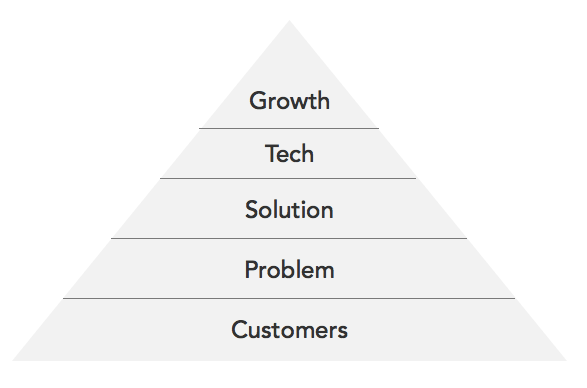The term pivoting has become something of a business banality. Any time any sort of problem arises for an entrepreneur, a “wise” mentor will sagely shake his or her head and utter pivot, as if it was some mystic cure-all. As a result, people take a variety of actions claiming that it is a pivot which will lead to a stronger business. More often than not, those actions lead to dead ends.

This is a shame, because a pivot is powerful if put into play the right way. Pivots are a natural extension of the lean business model, which requires you to incrementally experiment to discover how to build a better startup. Many times, experimentation reveals that assumptions you held about your business are wrong and you need to make a change. Pivots are about making the right type of change. Think about the physical process necessary to pivot. You must plant one foot on solid ground and move around that point. Similarly in business, when you pivot you have to plant yourself in what you know from your experimentation and move around that point.
Before you ask if and when you need to shift your business, you need to ground yourself in the right frame of mind so you can best act on the trends you discovered from your application of lean business model principles. This post will provide the information on which you can rely on while pivoting your way to a better company.
Pivots in Perspective
Pivots can have a lot of definitions, but the one that is most appropriate in context of the lean startup method is “changing one aspect of your business model while keeping other aspects constant.” Simple to say, but difficult to apply because what you change can have significant effects on the other aspects of your business.

Consider the Pivot Pyramid provided by Selcuk Atli. Each level of the pyramid represents an aspect of a business model, where each previous level defines how the current level is constructed. For example, the customers you wish to target heavily define what problem you are going to solve. The problem you wish to solve is going to define your solution. If you pivot to a different customer base, not only is that going to influence what problem your business is going to try to solve but the answer you are going to provide. This is why it is absolutely crucial to try to find your product-market fit before you start prototyping answers and products. The more effort you put into the prototyping before locking down your target customer base, the greater risk you run in terms of building a product without a market.
Pivot vs Optimisation

The lean startup method places a high premium on experimentation, but there are two types of experimentation you can run; optimisation and pivot experiments. Optimisation experiments are about refining parts of a business model so that it can be more profitable. Pivot experiments are about validating parts of business model to ensure that is scalable and repeatable. In other words, optimisation is about making a business model better while pivoting is about finding a business model that works.
The best pivoting business strategy is to do all pivot experiments first. You need to be methodical and test until confident in every level of the Pivot Pyramid before moving on to the next one. Establish your target customer base first, then identify your problem, and only after you have a high level of confidence in those answers move on to testing which answers and products work best. Optimisation of a business model should never occur you are confident that it is feasible and sustainable.
Designing the Perfect Pivots
Pivots are a function of experimentation, something you only do if and only if an assumption you had about your business is proven to be verifiably false. Pivots should be focused on one of three classes of questions:
- Who has the problem?
- What is the problem you are trying to solve?
- How:
- Do you solve the problem?
- Big is the market?
- Are you going to reach this customer?
- Will you make money?
In general, you should focus on the first two questions before pivoting to the how. This corresponds to the base layers of the pivot pyramid described above. These questions provide the foundation of what your pivot experiments should be about as they form the basis for any sound business model. If you design your experiments with these concepts in mind, you will begin to find a business model that works.
Good questions are a good start, but not enough. You need to ensure that the experiments you design are structured for success. Here are four steps, from Ash Maurya, about how to design the perfect pivot experiment:

Maximise Learning: The whole point is to learn how to build a better business model. You should be structuring these experiments so that each is incremental, allowing you to only focus on one aspect of your business model at a time. Don’t fear failure – some say that to optimise learning you should fail approximately 50% of the time. In pivot experiments, do not be afraid to test bold changes and see how those changes affect the outcome of your business model.

Focus on Retention: Businesses don’t survive because they make initial sales with customers, but because they provide an experience that keep customers coming back. Every experiment might require different metrics to gauge success, but the number one metric you should consider is how well the changes help your retention rates.

Minimise Waste: Each experiment has a cost in resources and time, and as an entrepreneur you don’t have a lot of either of those things. You need to design your experiments so that you can get the most information you can while minimising the resources spent. For early stage experimentation to verify product-market fit, consider using low-fidelity MVPs. These sorts of MVPs are designed to get you great information at a low price. So long as the MVP is aligned with one of the questions listed above, it will work.

Validate Qualitatively, Verify Quantitatively. In early stages of developing your startup, you are not going to be able to have large groups of people to test your potential pivot on. That is ok, because a lot of the biggest, best pivots come from decisive moves that can be verified by face-to-face conversations with a small group of test customers. If your potential pivot works with a small body of potential customers, you can move forward to verifying that it works with a larger group of customers. This saves you time, money, and limits any potential harm to your reputation from a bad pivot.
Follow these steps and you should make all the right pivoting choices. But even with the best of intentions, it can be easy to stray away from the process to make pivots based on something other than experimentation and fact.

Pivoting Away From Success
The problem with pivoting as a concept is that it is misunderstood. Pivoting can appeal to certain instincts that might not be the best for a young startup. For example, there Is a real tension between when knowing when to pivot and when to persevere. Testing and experimentation is necessarily done with small batches of participants. This begs the question of how big of a change someone should really make when provided with information from one of these test batches; the threat of overreacting to information and making unnecessary pivots is just as big of a risk as not making a pivot when you should.
There is also confusion about what can be pivoted. For too many people, pivoting is a function of product and nothing else. Pivoting can be related to anything that is part of the business model. Many successful companies never pivoted their product, but at some point they did pivot another aspect of their business plan such as customer segments and revenue models. Do not become so focused on whether to pivot your product that you do not focus on the other important parts of your business.
Which leaves the most dangerous, and alluring pivoting mistake at all. Pivots should be done based on information and feedback from carefully designed pivot experiments. However, many businesses choose to pivot based on other sources of information such as what is cool in the moment, whether a new approach will better help them secure funding from a particular VC, or even something that was on the morning news. It is tempting to follow these sorts of trends; after all these ideas must be backed by some sort of popular support and popular support means customers.
Pivoting is not about chasing trends but making moves based on reason and logic that you understand. As an entrepreneur it is not your place to follow, but to lead. That means sticking to your process but making changes when you have information you verified. If you follow the trends and practices of others you surrender your initiative, which is the greatest advantage you have as a business owner.
Pivoting correctly and for the right reasons can be quite the challenge, but one that you can successfully navigate. If you are looking for someone to partner with on the pivot experimentation process, consider reaching out to CobbleWeb. We can keep you grounded with data but flexible and agile enough to build a better business.
